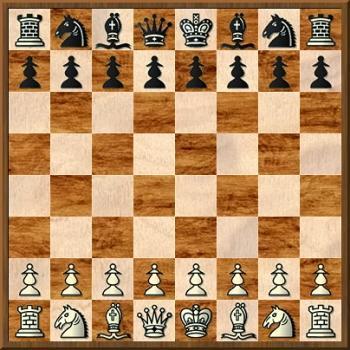
Edward Winter

W.H.Cozens (Ilminster, England) reports J.H. Blackburne’s comments on the Nimzo-Indian Defence (page 134 of P. Anderson Graham’s book). Englisch-Blackburne, London, 1883: 1 d4 e6 2 c4 Nf6 3 Nc3 Bb4. ‘Not much good comes of this. The best place for the bishop is at e7.’ (The game was drawn.)
The Complete Chess Course by Fred Reinfeld (Unwin Paperbacks, London, 1983) is a compendium of six separate books pasted together to offer a single volume that is good value, if confusing reading.
At a time when 1...a6 is being accorded serious theoretical consideration and Kasparov’s famous remark ‘Chess is not skittles’ is being unfavourably received in the context of 1 c4 g5, it is quaint to read some of Reinfeld’s flat statements on the openings:
Surely even beginners should not be deceived to this extent. And talking of deception, the publisher’s blurb tries hard to make out that Reinfeld is still alive, while darkly calling him ‘a former chess master’.
(499)
Annotating a game Judd-Ware in the Philadelphia, 1876 tournament book (reprinted by Olms), B.M. Neill writes of 1 e4 d5: ‘Inferior, and containing the seeds of defeat’ (page 99).
(1131)
Ed Tassinari (Scarsdale, NY, USA) points out that many assessments of the kind quoted in C.N. 1131 are to be found in the Hastings, 1895 tournament book, edited by H. Cheshire:
(1144)
Another over-vigorous bashing of the Centre Counter Game is by Burn (BCM, September 1914, page 335). He gives 1...d5 a question mark and writes: ‘Not a good move, as Black, on re-taking the pawn after the capture, has to lose time in retreating his queen.’
(1210)
Ed Tassinari provides two more outmoded opening assessments, from Capablanca’s Havana, 1913 tournament book:
(1236)
From Jerome Bibuld (Port Chester, NY, USA):
‘In C.N. 1131 you quote B.M. Neill in opposition to the Centre Counter. C.N. 1210 contains another disparagement, by Burn. I now offer the peak of the nineteenth century, Wilhelm Steinitz, who wrote in the International Chess Magazine (April 1885, page 116):
“The centre-counter gambit is unfavorable to the second player, being contrary to the principles of development, for it brings the Q too early into play in the centre and allows the opponent to gain time by attacking her with minor pieces.”’
Edward Janusz (Bricktown, NJ, USA) draws attention to a comment by Blackburne on page 122 of his games collection:
‘The English was once looked upon as sound but is now practically discarded.’
Our correspondent adds that ‘English Opening’ at the time may have meant just the move 1 c4 (even with transpositions into various Queen’s Pawn openings), and not an ‘actual system’.
(1320)
Some more outmoded opening assessments:
In each of the above cases the player of the ‘weak’ move lost the game.
On page 296 of The Art of Chess (London, 1895) James Mason wrote:
‘Fairly tried and found wanting, the Sicilian has now scarcely any standing as a first-class defence.’
Concerning Capablanca’s view on the Sicilian Defence (and, notably, his alleged ‘full of holes’ remark), see page 155 of Kings, Commoners and Knaves and C.N.s 3961, 10344 and 10383.
Ed Tassinari quotes a few comments by Max Euwe on page 32 of the November 1951 CHESS:
‘Bizarre - and Bad - Lines against the Nimzo-Indian Defence’
- 4 Bg5: ‘A move without significance.’ Euwe quotes only Réti-Marshall, Brno, 1928, where Black rapidly got the better of it after Réti erred.
- 4 g3: ‘Just as useless.’ He quotes Alekhine-Reshevsky, AVRO, 1938.
- 4 Nf3: In reply, ‘4...c5 represents a simpler way [than 4 ... b6] of equalizing.’
After 1 d4 d5 c4 one would hardly expect to find a twentieth-century master questioning the continuation 2...e6. Richard Teichmann did so, on page 463 of the November 1906 BCM. Following Black’s second move he wrote:
‘The latest experiences of Masters’ Tournaments shew that after all it is best to accept the Queen’s Gambit at once.’
(2168)
Daniel F.M. Starbuck – N.N.
Occasion?
Philidor’s Defence
1 e4 e5 2 Nf3 d6 3 d4 Bg4 4 dxe5 Bxf3 5 Qxf3 dxe5 6 Bc4 Nf6 7 Qb3 Qe7 8 Nc3 b6 9 Bg5 Nbd7 10 Nd5 Nc5 11 Qb5+ Qd7 12 Bxf6 Qxb5 13 Bxb5+ Nd7 14 Nxc7 mate.
The score is taken from page 77 of L’ABC des échecs by N. Preti (Paris, 1906), a 566-page volume whose coverage of the main openings was revised by Janowsky. We note in passing that when discussion of the Sicilian Defence began on page 355, the move 1...c5 was given a question mark.
(2936)
An addition comes from Chess Recipes by E.A. Greig (Stroud, 1914). Below is the book’s full coverage of the Sicilian Defence, which includes, at one point, a question mark for 1...c5:
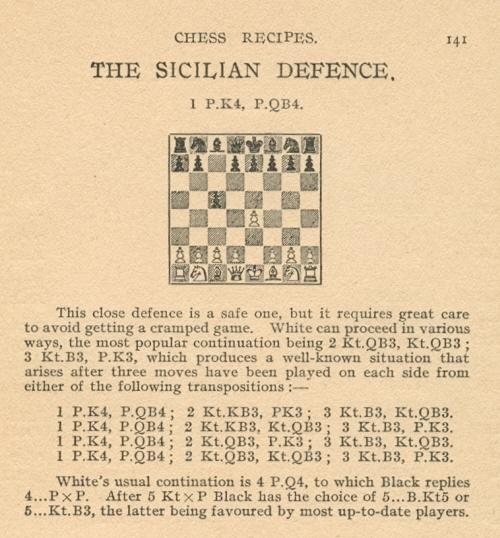
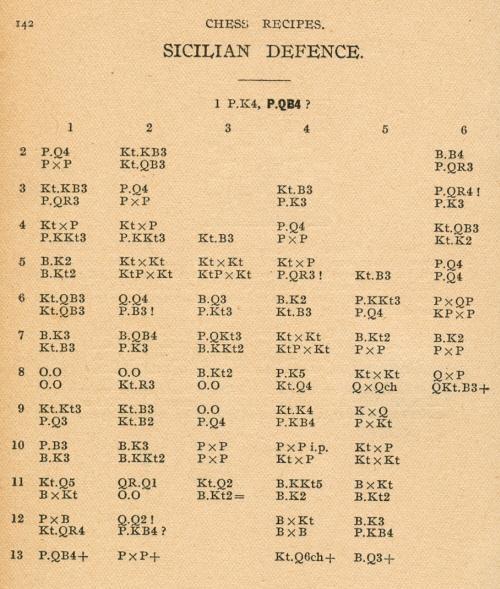
(6788)
Olimpiu G. Urcan (Singapore) notes a case of a leading master strongly criticizing an opening shortly before playing it in an important game. Our correspondent sends these extracts from the February 1905 American Chess Bulletin (pages 29-30 and 31 respectively):
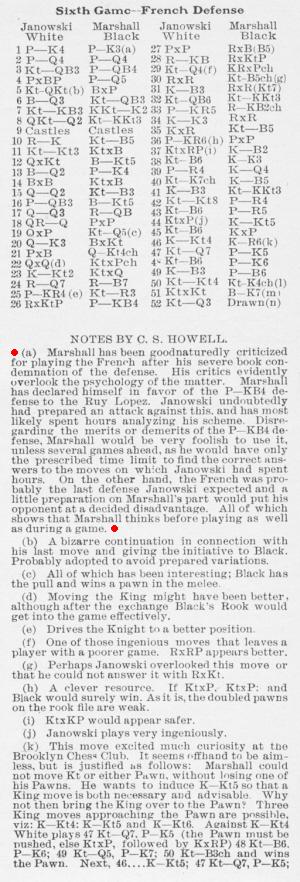
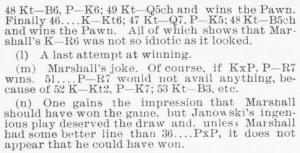
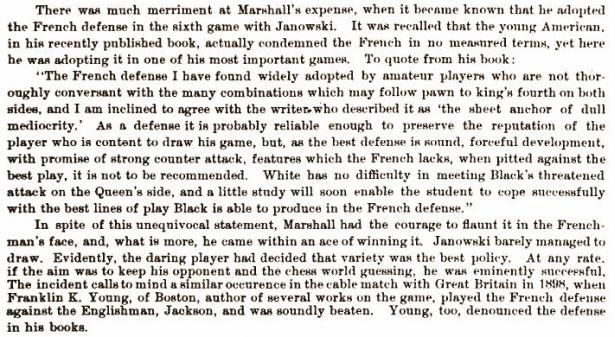
It will be recalled that Marshall played the French Defence (by transposition) in his most famous game, against Levitzky at Breslau, 1912. We add in passing that on page 27 of the February 1935 Chess Review Arnold Denker wrote regarding the conclusion of that game:
‘This is by far the finest and most artistic queen sacrifice that I have ever seen.’
(6984)
Staunton’s opening note, after 1 e4 e5 2 Nf3 Nc6 3 Bb5, in the first game in his match against Horwitz (London, 2 February 1846), on page 89 of the Chess Player’s Chronicle, 1846:
‘Habituated to the giving odds in every game for the last two or three years, White labours under a temporary disadvantage in playing “even” games with a player thoroughly versed in, and daily practising, the “book” openings; he very prudently, therefore, begins in a way to throw each party on his own resources as much as possible.’
A reaction appeared on pages 125-126 of the March 1846 issue of Le Palamède (edited by Saint-Amant):
‘Ceci est un mauvais début, généralement condamné, et sur lequel nous avons eu déjà occasion de nous prononcer toujours dans le même sens, bien que l’ayant employé nous-même. M. Staunton cherche à expliquer ce vice de tacticien en se rejetant sur ce que contre un joueur aussi expert que M. Horwitz, qui débute d’après les livres, il fallait se jeter dans l’inconnu pour retomber chacun dans ses propres ressources. C’est modestement dire que, dans ce cas, l’avantage serait pour lui. Nous lui ferons fort poliment observer que le début qu’il a adopté n’est rien moins que du nouveau: c’est du vieux, et ce n’est pas du meilleur, voilà tout.’
(9822)
Concerning the tenth match-game between Lasker and Schlechter in Berlin, 1910, on page 80 of Kings of Chess (London, 1954) William Winter wrote after 1 d4 d5 2 c4 c6:
‘It is curious that nearly all the contemporary annotators condemned this move. It is, of course, one of the best methods of declining the Queen’s Gambit.’
From the book’s Introduction (page 11):
‘... the solitary Slav Defence played by Schlechter against Lasker’s Queen’s Gambit caused a buzz of astonishment throughout the chess world. One English commentator went so far as to place a note against Black’s second move: “To this weak move may be attributed the loss of the game.” He quite ignored the fact that, at one period, Black held a winning position, but the remark is interesting as indicative of the narrow outlook on the openings during the first decade of the century.’
A spot-check of annotations written in 1910 suggests that the comments in Kings of Chess about the reaction to 2...c6 are an exaggeration. Two rare cases of outright condemnation of the move are on page 130 of La Stratégie, April 1910, attributed to, respectively, Tarrasch and the New Orleans Times-Democrat:
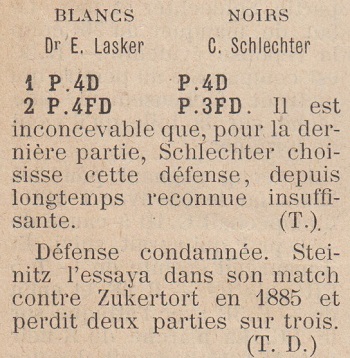
The New Orleans Times-Democrat (13 March 1910, page 9, part three) had not only the incorrect date 1885 but also a longer text whose second and third lines were inverted:

To the Chess Notes main page.
To the Archives for other feature articles.
Copyright: Edward Winter. All rights reserved.